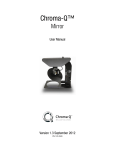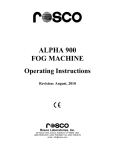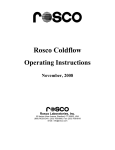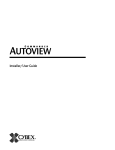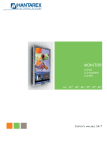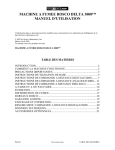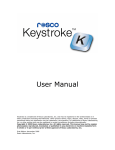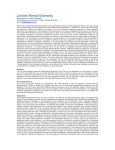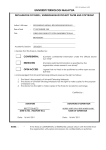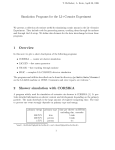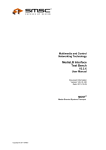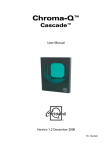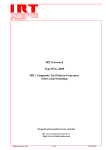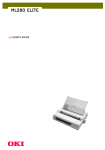Download I-Cue Operation Manual
Transcript
I-CUE INTELLIGENT MIRROR Operations Manual Table of Contents Product Overview pg 1 Product Description Operation Drawings I-Cue Mirror and Broadway scroller combined I-Cue Mirror used without a color scroller pg 2 pg 2 pg 3 pg 3 pg 4 pg 4 pg 6 pg 7 pg 9 pg 10 pg 12 pg 13 pg 15 pg 15 pg 15 I-Cue Intelligent Mirror Parts List pg 16 Unpacking the unit Control and power cables Connections Mounting the unit Operating the unit Modes of Operation Summary of Control Troubleshooting Technical overview Technical specifications Product Overview The I-Cue Mirror is designed to give years of trouble free use, providing that it is regularly maintained and is used in accordance with the instructions detailed in this manual. If you should experience any problems that fall outside of the scope of this manual, please contact the selling dealer for further details. If the selling dealer is unable to satisfy your servicing needs, please contact the following, for full factory service: ROTAD 1330 30th Street Suite G San Diego CA, 92154 Attn: Repair Department 800-468-0114 x25 pg 1 Product Description The I-Cue Mirror is a motorized mirror attachment which mounts onto fixed position spotlights to achieve many of the effects traditionally only available with high priced intelligent moving lights The compact and stylish design is equally at home in a theatre, exhibition centre, shopping mall, or car showroom. The moving mirror accurately redirects a fixed position beam of light through a pan of 230˚ and a tilt of 57˚, making it a very cost-effective and space-saving option for illuminating multiple locations using just a single spotlight. As well as being compatible with most standard medium and narrow beam profile fixtures, the unit can also be used with a color scroller to provide moving color and daisy chained to other lantern accessories to combine moving light with dynamic color changing and gobo rotating effects. The I-Cue Mirror is designed to operate either on the USITT DMX512 (1990) protocol or in stand-alone mode. The DMX serial data system allows for the individual addressing of multiple units on one data cabling system. The unit is addressed by using the three push button switches and LED display. The unit equipped with a diagnostic section on the LED display showing Power, DMX signal and level presence. When operating in stand-alone mode, the I-Cue Mirror only requires a 24 VDC supply to operate. Note: The quantity of I-Cue Mirrors used and the maximum cable length per power supply output is dependent upon the size of PSU/splitter box used. Operation • Unpacking the Unit • Control and power cables • Connections • Mounting the unit • Operating the unit • Modes of operation • Troubleshooting • Technical overview • Technical specifications pg 2 Unpacking the unit The I-Cue Mirror package comes with the following items: • I-Cue Mirror • Safety wire (supplied fitted) • User manual The unit is shipped in a specially constructed shipping carton to provide protection to the unit. Carefully open the carton and remove the unit by grasping the support arm in the middle and lifting the unit vertically out of the carton. Next, carefully remove the rubber restraint band used to stabilize the mirror unit during shipment. Note: The packing material protects the fixture during shipment; always use it to transport the fixture. The front light shield had been designed so that it can act as a shipping support and must be repositioned before using the unit. Loosen the two M4 wing screws on the front of the unit and reposition the light shield by moving the shield downward to the position necessary to prevent light leaks depending on the beam angle and focusing. Control and power cables The I-Cue Mirror utilizes an XLR 4-pin cable system. In DMX mode, this is used to supply power and data transfer. Pins 1 and 4 are supply 24V DC power. Pins 2 and 3 supply USITT 1990 DMX512 control protocol, with a ground/drain wire to the connector shell. For use in ‘Stand-alone’mode, the unit requires a suitable 24V DC connected to Pins 1 and 4, with a ground/drain wire to the connector shell (not required, but suggested). Damage will occur if power connections short to data or ground/shield connections. When assembling XLR 4-pin cables, heat shrink should be used on each individual pin to prevent short circuits. (See diagram on following page.) Note: It is very important to ensure that the drain wire from the cable shield is connected to both the XLR connector cases. pg 3 Detail of connector wiring (typical) The correct wiring between male and female connectors is ‘one to one’. Pin # Function Minimum Cable size 1 2 3 4 Chassis Ground (-ve) Control data minus (-) Control data plus (+) 24 VDC (+ve) Cable shield/Drain wire 2.50mm_ (14 AWG) 0.35mm_ (22 AWG) 0.35mm_ (22 AWG) 2.50mm_ (14 AWG) 0.25mm_ (24 AWG) (Note: Cable length should not exceed more than 75 M (250’) with return line) Connections Correct connection of the units to the power supply will decrease the chances of units malfunctioning due to cabling problems. Please follow these basic rules: a) Use the correct and gauge type of cable and connectors. b) Keep cable runs as short as possible to reduce line loss. c) Always use a return cable for each run. This will ensure balanced DC power to all units that the line is correctly terminated and that all units receive power if one link of the chain is faulty. pg 4 Mounting the unit For proper operation, the unit must be firmly attached to the light fixture it is mounted on. To achieve this, the mounting plate of the unit has two flat springs at the outer edge. The unit is designed to mount in the rear color frame slot of the ellipsoidal fixture. The back plate should be inserted in the rear color slot and gently pushed down until the unit is firmly seated in the bottom of the slot. The safety wire supplied with the fixture should then be attached as a means of secondary fixing. Input power and DMX should be brought to the unit by way of XLR-4 cable. If daisy chaining is desired, a XLR-4 cable should be run from the output connector on the unit to the next device in the chain. When DMX is first applied to the unit, it will go through a homing sequence, which will cause the mirror to momentarily move around. Note: If the rear slot is not available for mounting of the unit because of the use of a gel holder in this slot, the front slot may be used for mounting instead. I-Cue Mirror mounted on a lighting fixture. Ensure the safety wire is used as a means of secondary attachment. pg 5 Operating the unit All the unit functions are accessed using the LED display and the three push-button switches on the left side panel. 3 digit Display Red Button Control RED button BLACK button BLUE button 3 digit display Black Button Blue Button Function Mode access and ‘Record’ Decrements the mode level, or value Increments the mode level, or value Displays modes, monitor, or blank display. PUSH BUTTON OPERATION: The RED button is used to scroll through the different modes of operation, and the BLUE or BLACK buttons used to select the level, or value, in that mode. If any mode or value is changed, the last digit of the display will flash until the RED button is pushed to acknowledge (or record) the change. DISPLAY OPERATION: Power-up Display On power-up, the display will show ‘ini’ during the initialization sequence, and then show the DMX address. MONITOR DISPLAY: If left undisturbed for 5-7 seconds, the display will revert to ‘Monitor Mode’ • The first vertical bar indicates that there is Power (24V DC) at the unit. • The second vertical bar indicates that there is Data (DMX) at the unit. power data signal level • The horizontal bars indicate the data Signal Level (DMX) at the unit. (See also: ‘Troubleshooting’ section of this manual) DISPLAY FLIP: The display-viewing angle can be flipped through 180˚ by pressing and holding the RED button, then pressing the BLACK button. pg 6 DISPLAY BLANK: The display can be set to auto-blackout after short time. This is selected through the mode menu. (See later in this section) RESET: If the RED button is held down, and the BLUE button pressed, the unit will reset to the factory default settings. This feature is particularly useful when the units are use in many different configurations/shows. Modes of Operation EFFECTIVE (STAND-ALONE) MODE In this mode, the unit can be used without a DMX control signal; only a 24v DC supply is required. To use the stand-alone mode; • Connect a suitable 24V DC power supply to the unit. • Press the RED button to scroll through the menu until the display reads ‘At0’. • Press the BLUE button once, so that the display reads ‘At1’ (Auto mode) and press the RED button. • Press the RED button to scroll through the menu until the display reads ‘Pn’. This accesses the mirror panning movement in the auto mode. Using the BLUE/BLACK buttons select the range of movement you require Pn0 – Pn7, continuous back & forth sweep Pn8, or mirror held at the centre position Pn9. Press the RED button to store the pan value and change the display to ‘tL’, the mirror tilting movement in the auto mode. • Repeat the above process to set a tilt movement value. • When the desired effect is selected, press the RED button DMX CONTROL MODE In this mode, the unit can be fully controlled using two or four DMX channels (see below). Acombined DMX and 24v DC supply cabling system is required in this system. Press the RED button to move between modes, and to record any changes made. DMX CHANNELADDRESS MODE This mode is used to set the DMX start address in the range of 1-511 (2 channels, 8-bit resolution) and 1-509 (4 channels, 16-bit resolution).The display shows the current DMX address. (To alter the address, press BLUE or BLACK button once to increment/ decrement the value; hold down the BLUE or BLACK for fast increments/ decrements of the value. pg 7 PAN / TILT MOVEMENT MODES These modes allow the user to reverse the direction of the pan, tilt, or pan and tilt motion, when the configurations of the lighting fixture/mirror unit dictate. The display shows either the pan movement or the tilt movement (‘Pn’ pan/ ‘tL’ tilt) and the current direction (‘0’= normal/ ‘1’ = reverse) of travel. (Press BLUE or BLACK button to switch directions, and the RED button to change modes.) DMX RESOLUTION This mode is used to set the movement resolution, or accuracy, of the unit. The unit operates either with two or four DMX control channels, or stand-alone mode (with no DMX control). The display shows the current DMX mode (‘rn0’= 8-bit or ‘rn1’= 16-bit resolution). (Press BLUE or BLACK to switch between modes.) DISPLAY MODE This mode is used to switch the display on or off. This feature can be used to blank displays that may be an unwanted distraction. The display will re-activate when any button is pressed. The display shows the current display mode (‘dP0’= display off or ‘dP1’= display on),(Press BLUE or BLACK to switch between on and off.) DMX / AUTOMATIC MODE This mode is used to select either DMX control or automatic (stand-alone) operation of the unit. The display shows the current mode (‘At0’= DMX control, or ‘At1’= automatic mode). (Press BLUE or BLACK to switch between modes.) pg 8 Summary of control functions: Note: - Press the RED button to move between modes, and to record any changes made. Mode Description Actions Required Display DMX channel address mode Sets the units DMX address. To alter the address, press BLUE or BLACK button once to increase or decrease the value; hold down the BLUE or BLACK for fast incre ments/ decrements. The display shows the current DMX address. In the range of 1-511 (2 channel, 8-bit resolution) In the range of 1-509 (4 channel, 16-bit resolution). Pan movement mode This mode allows the user to reverse the direction of the pan motion. To alter the mode, press BLUE or BLACK button once to switch between modes. The display shows that the PAN movement is set for normal direction. This mode allows the user to reverse the direction of the tilt motion. To alter the mode, press BLUE or BLACK button once to switch between modes. The display shows that the TILT movement is set for normal direction. DMX resolution mode Sets unit operating with 2or 4 DMX control channels, with 8 or 16bit resolution. To alter the mode, press BLUE or BLACK button once to switch between modes. The display shows the unit is set for 8-bit resolution. Display mode This mode is used to switch the display on or off. To alter the mode, press BLUE or BLACK button once to switch between modes. This shows that the display is set for auto-blanking. This mode allows the user to select to between DMX and Automatic modes. To alter the mode, press BLUE or BLACK button once to switch between modes. Tilt movement mode DMX/ Automatic mode The display shows that the PAN movement is set for reverse direction. The display shows that the TILT movement is set for reverse direction. The display shows the unit is set for 16-bit resolution. This shows that the display is set to be permanently on. The display shows that the unit is set for DMX control. The display shows that the unit is set for automatic operation. pg 9 DEFAULT SETTINGS: ‘Factory’default settings If the unit is reset, using the RED button (held down), and the BLUE button pressed for 2 Sec’s, the unit will revert to the factory default settings. The ‘Factory’ default settings put the unit in its normal operating mode. DMX Address = 001 Pan/tilt direction = Normal Resolution = 8-bit Display = On DMX/Auto = DMX Display Flip = Normal ‘USER’ DEFAULT SETTINGS Each time the RED record button is pressed, the unit will save that change and these ‘user defaults’ will take precedence on the next power cycle. These ‘User’ defaults can be reset to the ‘factory’ defaults using the method detailed above. Troubleshooting The LED display aids in the troubleshooting of the system. These indicators are located on the on the side panel of each unit. power data signal level The first vertical bar indicates that there is power (24VDC) at the unit. The second vertical bar indicates that there is data (DMX) at the unit. The horizontal bars indicate the data (DMX) signal level at the unit. Note: The signal level changes during normal operation of the unit, and is present during stand-alone operation. 1st bar = 25%, 2nd bar = 50% and 3rd bar = 75%. Note: A high percentage of problems are a direct result of poor cabling, corrupt DMX control signals, and lack of suitable signal termination. pg 10 SYMPTOM POSSIBLE CAUSE SOLUTION Unit does not respond to DMX control, but DMX display indicator is on. Unit set to wrong or different DMX address. Check DMX address settings. Unit does not respond to DMX, DMX display indicator is off. Bad cable. No DMX at splitter/PSU. Check cable and DMX run from the console. Units run at different speeds. Cable lengths are too long. No cable return line. Check the cable length and configuration. Ensure there is a cable return line in the system. Units have dim display indicators and run slowly. Overloading of chain or cable runs too long. PSU overloaded. Check voltage levels on last unit. Should not be below 20VDC. Display indicators appear OK but unit does not move. Mechanical (or electrical) failure in the unit. Turn unit on and off. Return unit for repair. The tilt doesn’t respond to DMX. 16-bit mode setting when 8-bit control is intended, or vice versa. Check and reset. Mirror panning/tilting in opposite direction. Pan/tilt reverse switch with improper setting. Check and reset. The mirror vibrates in one place when it is supposed to move. Broken motor cable Popped out motor connector. Contact distributor for service Reconnect and check pg 11 Technical overview The electronics card consists of four key components: L298 Motor driver (x 2), 75176 Transceiver, and a processor. The 75176 transceiver operates in the receive configuration to convert serial protocol to a TTL level. All data relevant to the operation of the unit is stored onboard in ‘flash’ memory. The majority of electronics problems are usually created by external factors such as shorted cables, etc. The 75176 transceivers are susceptible to damage if 24VDC is present on the DMX signal lines. Troubleshooting is a process of elimination. First, rule out the other field factors (i.e. faulty cables, power sources). If an electronics problem is suspected try replacing the electronics card first. If accuracy problems should occur, check for obvious mechanical problems. For technical advice and/ or parts, please contact your selling dealer or the offices listed in this manual. pg 12 Technical Specifications Dimensions: 260 x 230 x 265 mm (10.25” x 9” x 10.5") Weight: 1.6 Kg (3.5 lbs) Resolution: 8 or 16 bit Accuracy: Pan (230º Max.) (57.3º Max.) 0.9º 0.028º 8-bit mode 16-bit mode Tilt 0.225º 0.028º 8-bit mode 16-bit mode Movement Speed: 0-100% pan (max)= 2 sec 0-100% tilt (max)= 1 sec DMX Protocol: USITT DMX512 (1990) DMX Addressing: Digitally, via push buttons (3) and LED display Working Voltage: 24 VDC (+/- 10%) Power Consumption: 17 watts 0.7 amps Connectors: XLR-4 (male) in and XLR-4 (female) through Body Material: Steel Body Color: Black powder coat (Other colors available, P.O.A.) Mounting Plate: Integral mounting plate, designed for use in any ellipsoidal fixture with a 160 mm (6.25") gel slot. Max. Ambient Temperature 40º C (104º F) Cooling: Convection (natural) European Approvals: Pending North American Approvals: Pending pg 13 Specifications pg 14 Drawings I-Cue Mirror and Color Scroller combined. I-Cue mirror used with a color scroller. pg 15 I-Cue Intelligent Mirror Parts List Part IC-01 Mounting Plate Assembly Number 205 81001 0000 IC-02 Broadway Mounting Bracket 205 81002 0000 IC-03 XLR Connector Assembly 205 81003 0000 IC-04 Stepper Motor Lead (each) 205 81004 0000 IC-05 Safety Chain Assembly 205 81005 0000 IC-06 Mirror/Mounting Bracket Assembly 205 81006 0000 IC-07 Digital Control Card 205 81007 0000 IC-08 Stepper Motor (each) 205 81008 0000 IC-09 Mirror Back Plate 205 81009 0000 IC-10 Front Light Shield Assembly 205 8101 00000 Please call Rosco or your local Rosco dealer for pricing and availability. pg 16 Rosco Laboratories, Inc. 52 Harbor View Ave., Stamford, CT 06902 (203) 708-8900 1 (800) ROSCO NY FAX (203) 708-8919 1120 N. Citrus Ave., Hollywood, CA 90038 (323) 462-2233 1 (800) ROSCOLA FAX: (323) 462-3338 Rosco Laboratories, Ltd. 1241 Denison St. #44, Markham, Ontario, Canada L3R 4B4 (905) 475-1400 (888) ROSCO TO FAX: (905) 475-3351 Roscolab, Ltd. Blanchard Works, Kangley Bridge Rd., Sydenham, London SE26 5AQ England (208) 659-2300 FAX: (208) 659-3153 Rosco Iberica, S.A. C/ Del Oro 76A, Pol. Industrial Sur, 28770 Colmenar Viejo, Madrid, Spain (341) 846-3602 FAX: (341) 846-3634 Rosco do Brasil Ltda. Rua Antonio De Barros, 827, São Paulo SP Brasil CEP 03401-000 Te l :( 0 11) 218-2865 FA X :( 0 11) 218-0193 Rosco Australia Pty Ltd. 42 Sawyer Lane, Artarmon 2064, New South Wales, Australia (02) 9906-6262 FAX: (02) 9906-3430


















